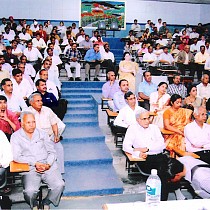IMPACT OF FARMSCAPING IN COWPEA ON THE DIVERSITY OF MAJOR INSECT PESTS AT POST-FLOWERING STAGE
Department of Entomology, Rajasthan College of Agriculture (MPUAT), Udaipur (Rajasthan) 313001
B. M. MEENA, R. SWAMINATHAN, R. NAGAR AND A. K. MEENA
A field experiment to study the influence of farmscaping on the seasonal abundance of major insect pests infesting cowpea at the post-flowering stage, under plant oil treated and untreated conditions, was carried out during the year 2012 at Instructional Farm of Rajasthan College of Agriculture, Udaipur. The major insect pests at post-flowering stage of the crop were the blister beetles, Myllabris pustular Thunberg and Myllabris phalerata (Pallas); the semi-looper, Trichoplusia ni Hubner, leaf miner, Cyphosticha coentlea Meyrick; and the spotted pod borer, Maraca vitrata (Fabricius). Under both untreated and treated conditions the mean density for all the major insect pests was relatively more in sole cowpea being 8.40, 3.40, 5.00 and 5.42 per cent and 7.19, 2.49, 4.17 and 4.73 per cent, respectively, than in the other farmscape treatments. The mean density of these pests was the minimum under both untreated and treated conditions in cowpea + marigold farmscape treatment and the corresponding values were 4.22, 1.48, 234 and 3.01 per cent and 328, 0.99, 1.15 and 2.15 per cent, respectively. The mean atmospheric temperature had a significant positive correlation with the population of blister beetles whereas, the mean relative humidity and total rainfall had a significant positive correlation with the population of pod borer; wile, the population of leaf miner showed significant positive correlation only with the mean relatively humidity.


